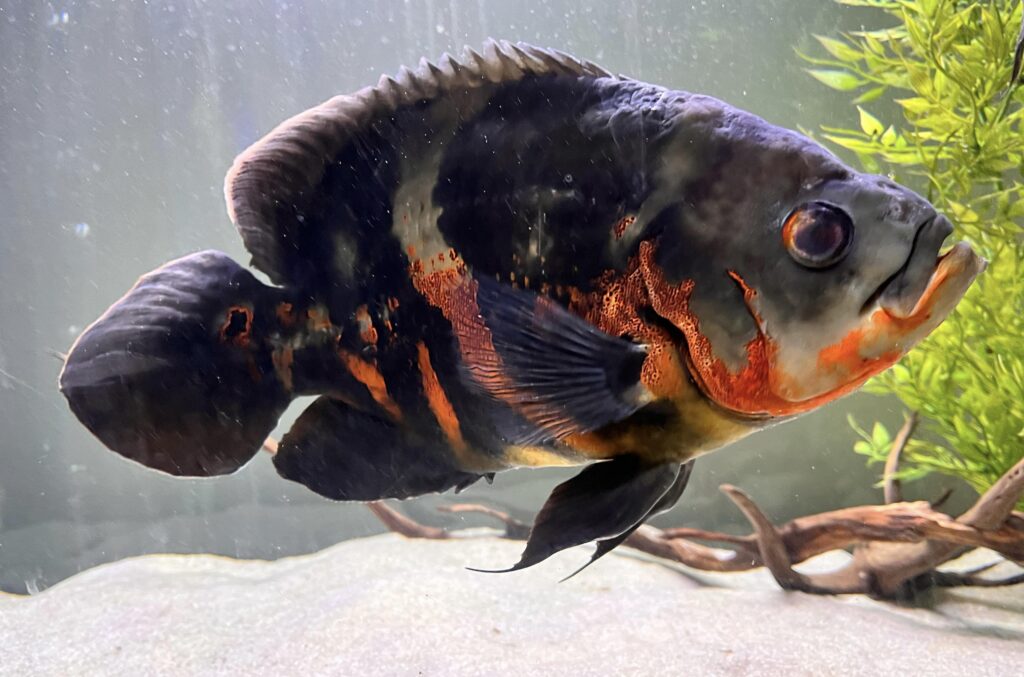
Resource Acknowledgment
The following resource was written for The Open Sanctuary Project by guest contributor Cameron Edwards. Cameron is the co-founder of Still Water Microsanctuary, which provides care and refuge for birds and fishes. They are also a co-administrator of the group Vegans With Fishes.
Resource Goals
- To understand generally the needs of fishes, and why they too need sanctuary;
- To learn about the fundamentals of water chemistry when it comes to providing sanctuary for fishes;
- To understand the basics of creating good living spaces for fishes;
- To learn about critical questions to ask when it comes to researching species-specific care for fishes;
- And to gain a basic understanding of transport, acclimation, and getting medical care for fishes.
The Question Of Non-Compassionate Sources
Information on the compassionate care of fishes is sparse. Much of the information that does exist is informed by those who stand to profit commercially from promoting the ongoing sale of fishes, and from unacceptable practices such as the capture and sale of wild fishes. We want to stress here that while we may refer you to certain of these sources, we take care to point out only those aspects of those sources that we consider helpful for the lifelong compassionate care of fishes. Such sources will be labeled as “Non-Compassionate” in our source list. If a source includes the (Non-Compassionate Source) tag, it means that we do not endorse that particular source’s views about animals, even if some of their insights are valuable from a care perspective. See a more detailed explanation here.
Introduction
When most folks think about animal sanctuaries, they likely think of species like chickens, pigs, cowsWhile "cows" can be defined to refer exclusively to female cattle, at The Open Sanctuary Project we refer to domesticated cattle of all ages and sexes as "cows.", donkeys, ducksUnless explicitly mentioned, we are referring to domesticated duck breeds, not wild ducks, who may have unique needs not covered by this resource. or llamas. However, animal sanctuaries need not be exclusive to us terrestrials! Sadly, billions of fishes are farmed every year, experiencing many of the same exploitative practices that other farmed animalA species or specific breed of animal that is raised by humans for the use of their bodies or what comes from their bodies. species experience. Further, they are also exploited through the “petAn animal who spends regular time with humans in their home and life for companionship or human pleasure. Typically a small subset of animal species are considered to be pets by the general public. trade,” which often results in fishes being treated as little more than expendable decorations by the general public.
Depending on your organization’s capacity, your ethical sanctuary or rescue could be just the place to give fishes in need compassionate care, and happy lives and share their narratives! We’ve covered ways in which your sanctuary or rescue could potentially advocate for fishes here, but in this resource, we are going to shine a light on the basics of fish care that you need to know in order to give them good homes at your sanctuary.
A Note On The Differences Between Salt And Freshwater Fishes.
Please note that there are differences in the care between salt and freshwater fishes, but the principles that are discussed below will apply generally to both. While this resource is meant to discuss general principles that are relevant to the care of all fishes, there will be differences between species (and we will offer you some research tips below!) that you will have to explore further. We look forward to creating future resources that will address these differences and even more detailed care information in more depth. We would also suggest that if you are just starting with the rescue of fishes, you start with freshwater fishes, since the care of saltwater fishes involves even more nuance.
Water Chemistry
In terms of importance, when it comes to the compassionate care of fishes, nothing tops understanding and maintaining water chemistry! Familiarizing yourself with the ins and outs of your water chemistry is absolutely essential to properly caring for fishes. This section will be the most extensive in this resource and should help to give you an idea if the care involved with offering fishes good homes is the right fit for your sanctuary. If the work involved in managing water chemistry feels overwhelming, fishes may not be the right choice for your sanctuary or rescue space! We’ll also include a recommended action steps checklist at the end of this summary for quick reference!
Don’t Expect To Become An Aqua-Chemist Expert Overnight!
This will take time to fully grasp. The good news is that you can fully explore and learn about your tank’s water chemistry without fishes in it by simulating waste with fish food or ammonia powder! This way, you can approach the care of your fish residents with knowledge and experience, and without making errors that are potentially harmful to your residents. The care of fishes isn’t something you want to jump into unconfidently or without a stable, cycled tank. We strongly recommend you practice cycling your tank prior to taking on fish residents!
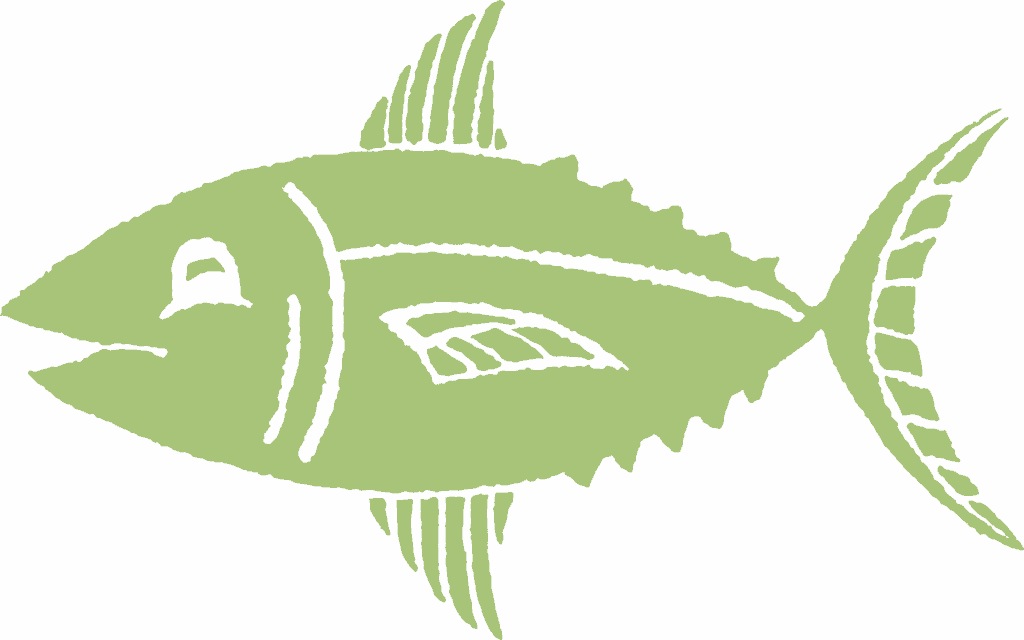
The Nitrogen Cycle
First and foremost, let’s become familiar with the nitrogen cycle. In the most basic of terms, this is the process that allows accumulating fish waste to not harmThe infliction of mental, emotional, and/or physical pain, suffering, or loss. Harm can occur intentionally or unintentionally and directly or indirectly. Someone can intentionally cause direct harm (e.g., punitively cutting a sheep's skin while shearing them) or unintentionally cause direct harm (e.g., your hand slips while shearing a sheep, causing an accidental wound on their skin). Likewise, someone can intentionally cause indirect harm (e.g., selling socks made from a sanctuary resident's wool and encouraging folks who purchase them to buy more products made from the wool of farmed sheep) or unintentionally cause indirect harm (e.g., selling socks made from a sanctuary resident's wool, which inadvertently perpetuates the idea that it is ok to commodify sheep for their wool). the fishes producing said waste. How does it work? Fishes are fed, they produce waste, and the nitrogen cycle begins! Uneaten food and fish waste produce Ammonia. Beneficial bacteria that reside in your filter consume the Ammonia and convert it into Nitrite. Next up, Nitrite is converted to Nitrate. One little letter makes a big difference!
A Note On Filters
Choosing an appropriate filter for your tank, as well as for the species residing in it, is important. The following are general suggestions, not steadfast rules. Smaller tanks (somewhere around 30 gallons and below) are best suited with “hang on back (HOB)” filters and/or sponge filters.
With regard to bettas specifically, they require minimal current due to their heavy fins and bodies. Consider a filter “baffle” for your betta’s filter to suppress water flow. Larger tanks often work best with canister filters. Though expensive, check out the FX4/FX6 canister filters for tanks over 75 gallons. Massive tanks over the 200-gallon range will likely require a sump system or multiple large canister filters. No matter your filter type, always stay on top of regular filter maintenance! For more on this, read on!
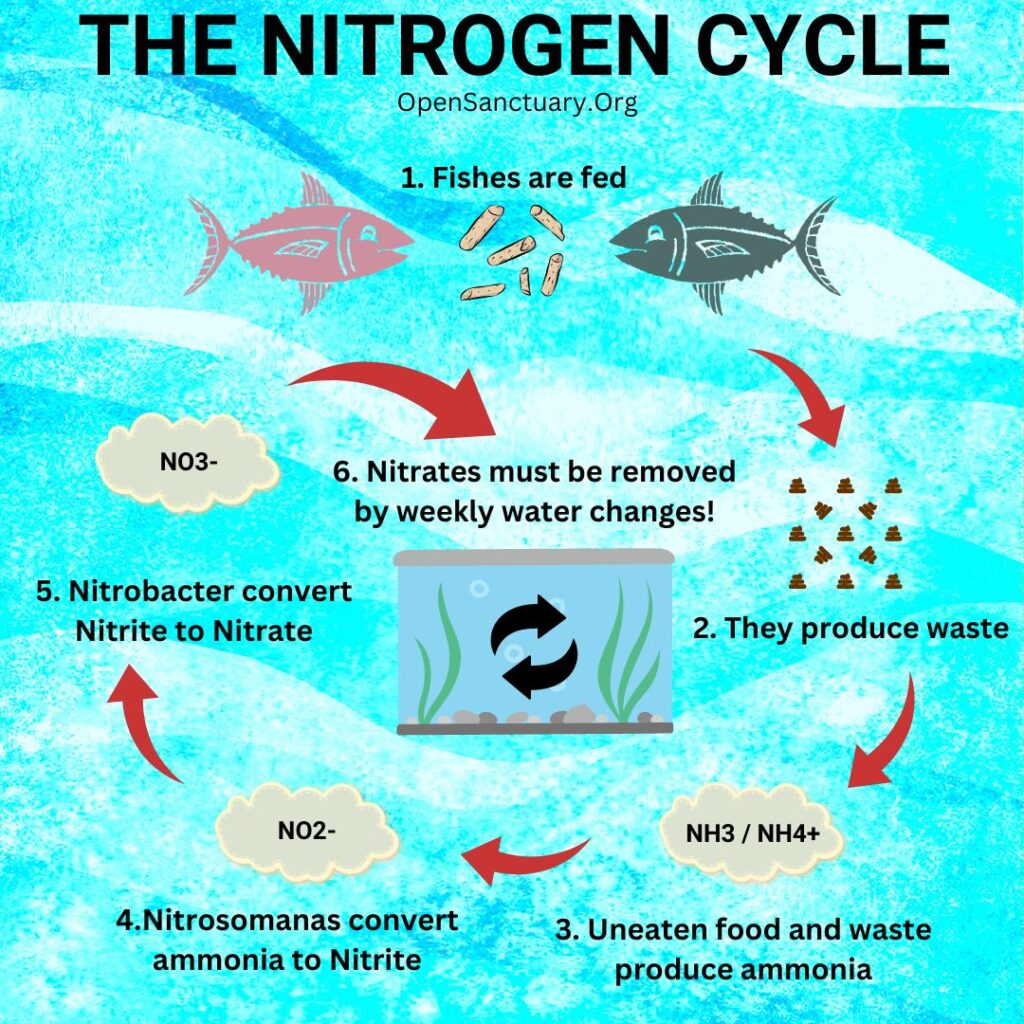
What Does Cycling A Tank Mean?
Before we get too much further into the details of the nitrogen cycle, let’s offer a quick definition of what cycling a tank means! When you cycle your tank, you are creating a biologically safe environment for your fishes. Cycling involves regulating the nitrogen cycle by mitigating the buildup of ammonia caused by the breakdown of fish waste with nitrifying bacteria, and also with weekly water changes!
Know your beneficial bacteria: Nitrosomanas and Nitrobacter! Nitrosomanas converts Ammonia to Nitrite. Nitrobacter converts Nitrite to Nitrate. When cycling a tank, Nitrosomanas will show up before Nitrobacter, meaning you’ll see Nitrites before you see Nitrates. You can purchase cultured beneficial bacteria in bottles to speed along the cycling process. A great option that has worked well for many caregivers is Seachem Stability.
The conversion of Nitrites to Nitrates is the end of the road for your beneficial bacteria! There are no Nitrate-consuming bacteria, so you’re up next, human! Nitrates must be removed via water changes. We cannot recommend weekly partial water changes more strongly. There is no substitute for them in terms of maintaining your water chemistry. We’ll discuss the reasons for this more below!
Partial Weekly Water Changes Are A MUST!
Even small traces of Ammonia and Nitrite are toxic to fishes. Nitrates are harmful in high amounts. Ammonia burns gills and tissue and harms a fish’s central nervous system. Nitrites inhibit a fish’s ability to carry oxygen through their bloodstream. Nitrates, in high amounts, negatively impact a fish’s growth and are associated with decreased oxygen levels for all fishes, putting strain on the fish, and leaving them more susceptible to disease. There are some great how-to videos on YouTube for water changes – this video demonstrates the proper “lawn mowing” technique to use when performing water changes.
When performing water changes, there is no need to remove decor, plants, or the fishes themselves from the tank. It is, however, a good practice to vacuum the substrate underneath decor. Once vacuuming under something make sure to put it back in place, as many fishes don’t appreciate their home being “redecorated!” Another thing to keep in mind is rooted plants. It’s okay to leave them largely undisturbed during water changes. Waste build-up around roots will serve as fertilizer to these plants.
How much water you remove each week will depend on what keeps the nitrates in your tank low. There are a couple of factors to this: bioload (how much waste is being produced) and your filter maintenance schedule. This is why regular testing is so important. It allows you to get to know your tank’s chemistry. Weekly nitrate testing should be done before water changes for the first couple of months after adding fishes to your cycled tank.
After this period, you can switch to testing nitrates a couple of times a month to ensure levels remain low. If nitrates are high, larger water changes may be necessary. Despite what many believe, there is no “maximum” amount of water you can take out in one water change. What does matter, however, are the fishes in the tank. If nitrates get high, their bodies become accustomed to it. Adding water back too quickly can put a fish into “nitrate shock”. If nitrates are high and you do a big water change, remove the fishes from the tank and reacclimatize them to the new water via the drip method. Multiple water changes over consecutive days may be done in order to avoid this risk, but consider adding pre-cultured beneficial bacteria (like Seachem Stability) after the change, as you may have lost some of the beneficial bacteria during them.

Helpful Water Change Tips
When adding your water conditioner (Seachem Prime), add the first half of the dose when you start filling the tank and the second half when you finish.
Don’t leave the vacuum tube unattended. Smaller fishes can be sucked up the tube.
ALWAYS ensure the water you are filling with is the same temperature as the tank water.
Unplug your filter and heater during water changes.
Here is a basic list of must-haves for establishing and maintaining a healthy nitrogen cycle. The products recommended below are not the only products available for this purpose, however many rescuers have found success in using the following:
- API Freshwater Master Test Kit (dropper bottles, never strips.) While strips may be easier to use, they are not as accurate as dropper bottles and, thus, are not as effective in your water testing.
- API GH & KH Test Kit (again, use dropper bottles, never strips.)
- Seachem Prime. This is your go-to water conditioner. The purpose of a water conditioner is to neutralize chlorine in your tap water. Chlorine is poisonous to fishes. Prime is a recommended water conditioner for a couple of reasons – it temporarily detoxifies ammonia, nitrites, and nitrates for 24 hours (particularly helpful if you find yourself unprepared with your first fishes). It also neutralizes heavy metals in the tap, as long as they’re not at excessive levels (if you do have excessive heavy metals, check out Seachem Cuprisorb!)
- Proper filtration (please see our note on filters above!) Also, you will need plenty of filter media (where most of the beneficial bacteria live) – Seachem Matrix is a good media option. Avoid the use of activated carbon! Activated carbon only lasts for a short period of time, and if not immediately removed once depleted, it will leach toxins into the water. There are also no visual clues that will help you determine when activated carbon has been depleted.
- Gravel/sand vacuum for water changes
- Seachem Stability (cultured bacteria.) This is not completely necessary but very helpful!
- An ammonia source – Fritz Ammonia is a good option (better than the old-fashioned way of using fish food)
- While not related strictly to the nitrogen cycle, you will also generally need thermometers for your tanks. Use at least two mercury-based thermometers made specifically for aquariums to ensure accuracy. Also, ensure the thermometer used to adjust water temp for refilling post-water change displays the same temps as the ones in the tank. Avoid digital thermometers. They are notoriously inaccurate and can become more so as batteries deplete.
A Note On Product Suggestions
There may be occasions where The Open Sanctuary Project references commercial products or brands within our resources, such as types of commercial food for animals, medications, tools, and other supplies. These references are solely for the convenience of our readership, and the products and brands can typically be further researched to find an equivalency that suits each sanctuary’s or caregiver’s individual needs. The Open Sanctuary Project does not endorse any product or brand, nor do we receive sponsorship from any product or brand. We work to ensure that all products listed are suitable for the situations listed, but please know that products often change their ingredient mix or construction, which may make them less effective or less suitable than when originally referenced in our resources. Finally, please know that it is not uncommon for a brand to carry products that may be suitable in a sanctuary environment in addition to products that are not suitable.
Eventually, your filter will need maintenance. On average, filter maintenance should occur once every 3-4 weeks (frequency may increase, depending on the bioload of the tank). Whatever schedule keeps Nitrates low is the right schedule for your tank. Never perform filter maintenance within 48 hours of a water change, as this may put too much stress on your tank’s beneficial bacteria and could cause the cycle to crash. You can find a good video on filter maintenance here.
You can find two helpful cycling guides here and here. Please note that while we consider both of these sources to be non-compassionate, both do stress the importance of cycling your tank prior to introducing fish residents to it. Again, when cycling, we recommend that you consult the list of products referenced above or find similar quality products. These have been tried and tested by many compassionate caregivers. We do recommend certain non-compassionate sources for guidance on some of the aspects of cycling, but we recommend that you do not rely exclusively on the products these guides recommend. Instead, if you cannot find the products we recommend above, we suggest that you consider consulting with other compassionate caregivers either directly or ask questions in compassionate caregiving communities prior to trying other products.
If you find yourself in a situation where you can rescue fishes but you do not have a cycled tank, there are still some measures that you can take to ensure their safety. This emergency-cycling guide can help you in such a case. After your tank is cycled, remember to test your water parameters on a regular basis. This will keep you on top of keeping your fish’s environment a safe place for them.
Please Remember To Keep In Mind The Ethical Challenges Of Responsible Rescue!
It is probably fair to say that most sanctuary caregivers have been confronted with situations where they are asked to help an animal with whom they may not be fully familiar, or for whom they may not yet have a prepared and safe space. Making decisions in these situations can be fraught, and we do have a resource on the subject that can help guide you in your decision-making process in these contexts. In the context of fishes, given the complexity of their care, if you are interested in committing to long-term rescue work for them, it may be worth considering keeping cycled tanks without fishes in them at the ready so that you are prepared should you get a call about fishes in need of rescue! However, do remember that if needed, you can “borrow” cycled media from an already cycled tank to establish a new one. To learn even more about responsible rescue specific to the context of fishes, please check out this guide published by the Microsanctuary Resource Center and Friends of Philip, found here!
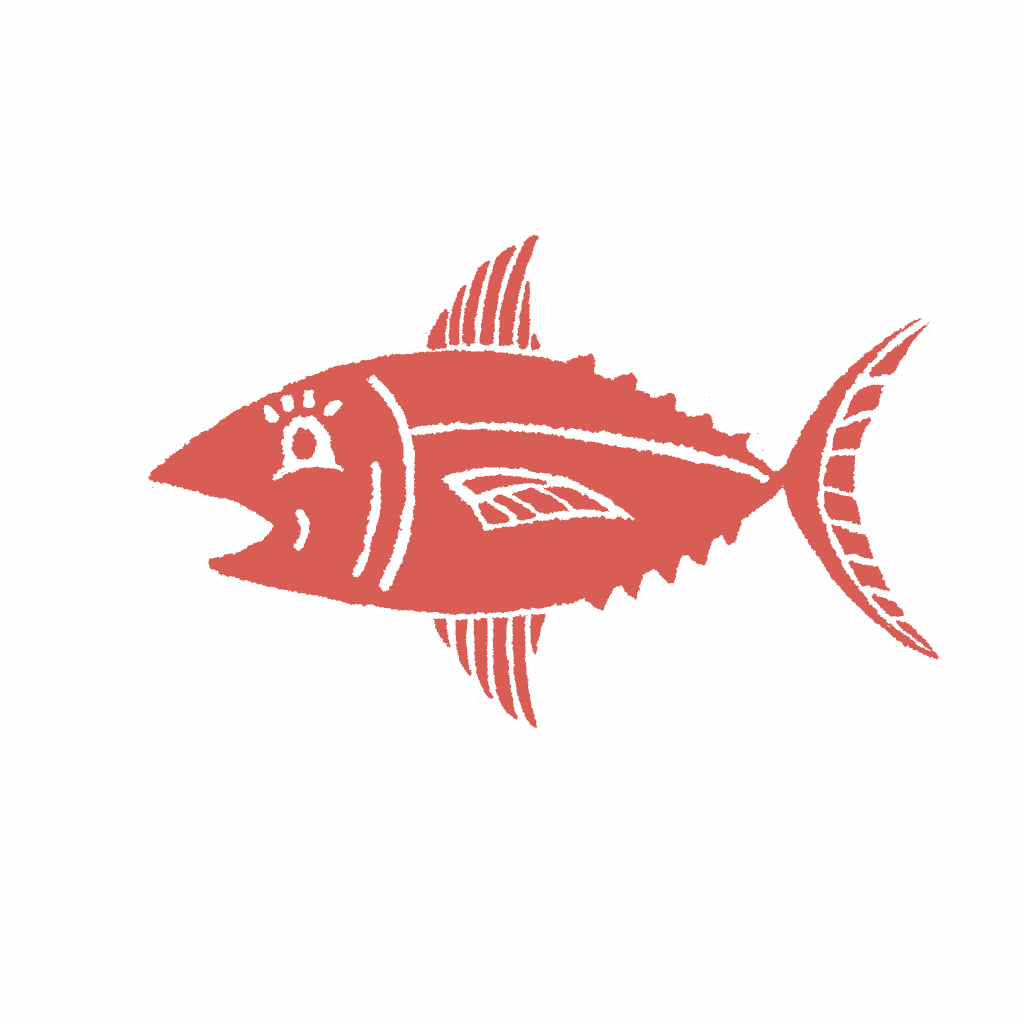
What About The Role Of Plants? Don’t They Help Regulate The Nitrogen Cycle?
While it is true that if a tank has sufficient planting, the plants can absorb some of the Nitrates, this can create a false sense of security. Plants can produce Ammonia and waste in the same way that your fish residents can, and if they are not in good health or are dying, can complicate things. Even if a tank has many well-established, healthy plants, they will not replenish KH levels (discussed further below) so the importance of weekly water changes cannot be overstated. We’ll discuss plants even more below!
Knowing Your Water Source’s Carbonate Hardness (KH)
Not all water is created equal in the world of fish care. Let’s first discuss Carbonate Hardness, abbreviated KH. KH is commonly overlooked but make no mistake, keeping it in mind is vital in providing your fishes a safe environment. KH is the total alkalinity in a fish tank. It is the measurement of carbonates and bicarbonates that exist in the water. The reason KH is important is because it’s what protects your pH.
What Is pH?
In chemistry, pH refers to the acidity or basicity of a liquid. It is defined as the measurement of hydrogen ions (and hydroxide ions) in a solution. The pH scale runs from 1 to 14. Pure water is considered to be neutral (neither acidic nor basic) and has a pH of 7. Hydrogen ions create an acidic environment (<7.0), and hydroxide ions create a basic environment (>7.0). If the pH is neutral (7.0), there are an equal number of hydrogen ions and hydroxide ions. If the pH is less than 7.0 (acidic), there are more hydrogen ions. If the pH is more than 7.0 (basic), there are more hydroxide ions. Both of these ion types are naturally produced in fish tanks.
KH is often referred to as your tank’s “buffering capacity” because it keeps your pH from fluctuating. Sudden pH fluctuations are very dangerous for fishes. Sudden pH changes bring on the same dangers that fishes face when they are introduced to new water without being acclimated. (More on acclimation below)! A sudden pH change will make your tank’s water feel like new water to a fish, causing serious harm and possibly death. This generally doesn’t happen in the wild (save for some unique scenarios), so a fish’s body isn’t equipped to deal with those sudden unnatural fluctuations.
Let’s dive into KH a little further. The question answered here is “How does KH protect pH?” Consider the following example. The beneficial bacteria in your filter produce hydrogen ions when converting ammonia to nitrite and nitrite to nitrate. When ammonia is produced, it reacts with water resulting in ammonium hydroxide. This breaks down into ammonia and a hydrogen ion.
Without carbonate hardness, these ions would raise or lower the pH. The KH works to ‘neutralize’ these acids and bases, keeping your pH stable and safe for fishes. The way it does this is by reacting with stronger acids and bases, making them significantly weaker so that they won’t change pH in any measurable way. What if your KH is too low? A decent KH for your water source (your tap, etc) will be over 4dKH, which isn’t very much, but will be a sufficient buffering capacity as long as weekly water changes are performed. One reason that weekly water changes are so critical is that they help to replenish your water’s KH, keeping the pH stable. Without frequent water changes, your tank’s buffering capacity will run out, allowing the pH to rapidly swing up and down (this phenomenon is referred to as “old tank syndrome”). Caregivers who don’t do water changes run out of buffering capacity in their tank, making it “old.” Water changes keep your tank “young!”. If your KH is 3 or less, consider adding an alkaline buffer with each water change. Seachem makes a great one called Alkaline Buffer. They also have a very handy dosage calculator on their website if you find yourself confronted with low KH levels!
Check out the following downloadable chart to use as a guide to pH, KH and GH, which you can download and print for easy reference! This chart can serve as a quick reference for the different aspects of water chemistry that you will want to stay aware of, and make sure that you monitor regularly as you care for your fishes! If you’re wondering more about GH, we’ll talk about that shortly!
pH, KH and GH Graph by Cameron Edwards and Julia Magnus
There are four columns. The first column lists descriptive categories, including: measurement type, units, what it measures, understanding measurements, and what it means for fishes.
The first measurement type is pH or power of hydrogen. “Units” for pH are described as “measured on a scale of 1 to 14. Aquariums typically operate between 5.5 – 8.6. Under “What it measures” the pH column reads “pH measures the amount of hydrogen and hydroxide ions in liquids and tells you how acidic or basic your water is.” Under “Understanding measurements” for pH, the chart reads “Pure water is neutral with a pH of 7. Hydrogen ions create an acidic environment (less than 7.0). Hydroxide ions create a basic environment (greater than 7.0). Under “What it means for fishes” the chart reads “Sudden pH fluctuations are very dangerous for fishes causing serious harm and possibly death.”
The second measurement type is KH or carbonate hardness. “Units” for KH are described as “KH is measured in dKH (degrees of KH) or ppm (parts per million), where 1 dKH equals 17.9 ppm.” Under “What it measures” the KH column reads “KH measures the amount of carbonates and bicarbonates in water, and thus its buffering capacity.” Under “Understanding measurements for KH, the chart reads “KH is buffering capacity. A decent KH is over 4dKH, which acts as a buffer to pH as long as weekly water changes are performed.” Under “What it means for fishes” the chart reads “KH neutralizes acids and bases, keeping your pH stable and safe for fishes.”
The third measurement type is GH or general hardness. “Units for GH are described as “GH is measured in dGH (degrees of GH) and ppm, where 1 dGH equals to 17.9 mg/L or 17.9 ppm.” Under “What it measures” the GH column reads “H measures the amount of calcium and magnesium ions in the water.” Under “Understanding measurements for GH, the chart reads “0-4 dGH means your water is very soft. 18-30 dGH means your water is very hard.” Under “What it means for fishes” the chart reads “Most fishes can adapt to a wide range of GHs, but keep it within reason and check for species requirements.”
At the bottom of the chart is an asterisk with a note that reads: “For all of these measurements, maintaining consistency is key!”
Recommended Action Steps For Mastering Water Chemistry: A Checklist
- Cycle your tank BEFORE you add fishes to make sure that you have stable and consistent pH, KH, and GH levels! Also make sure you test before adding fishes, and acclimate those fishes as discussed in our section on acclimation below!
- Test your water regularly! Weekly nitrate testing should be done before water changes for the first couple of months of adding fishes to your cycled tank. After this period, you can switch to testing nitrates a couple of times a month to ensure levels remain low.
- Do partial water changes weekly to prevent nitrates from building up to toxic levels!
- Make sure to stay on top of your filter maintenance, which will depend on what model of filter you use as well as your tank’s bioload!
Living Spaces
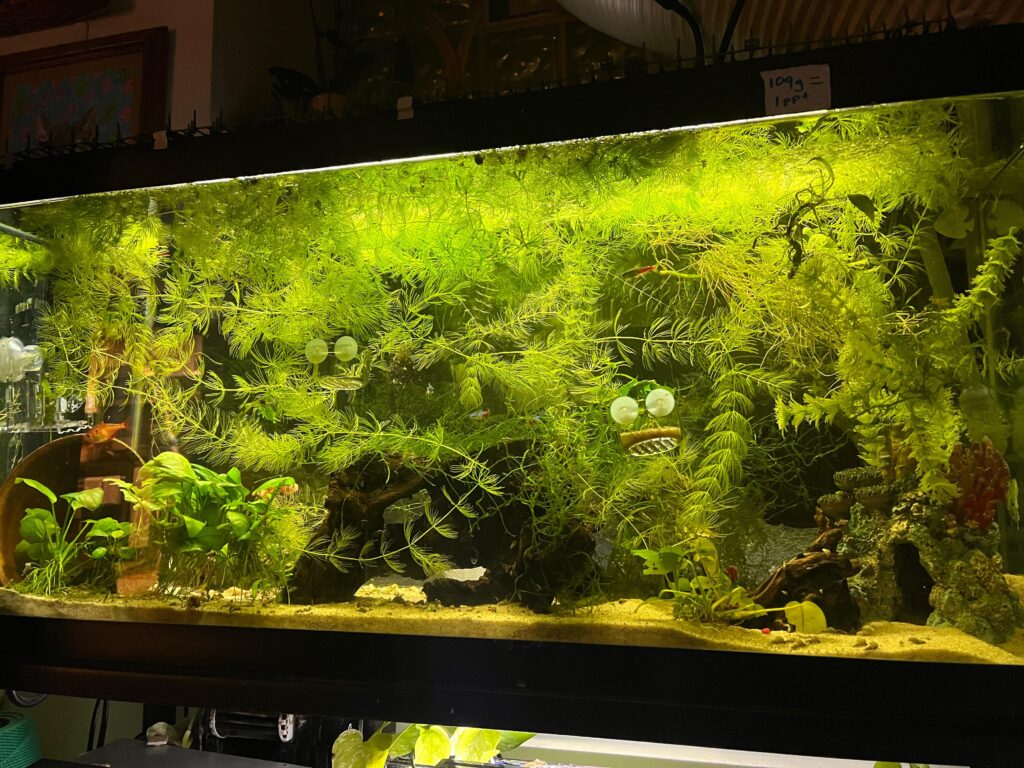
Now that we’ve gone through the essentials of water chemistry let’s talk about living spaces! Your fishes’ living spaceThe indoor or outdoor area where an animal resident lives, eats, and rests. is important! Cosmetically, you should provide a natural-looking environment for your fishes, as much as possible. Stay away from unnaturally colored substrates and decor. Aquariums are already unnatural. Bright colors will stress your fish out. They didn’t evolve alongside neon pink rocks, so don’t give them neon pink rocks to look at. Shoot for aquarium-safe driftwood, stones, hides, live plants, and a naturally colored tank background. Also, keep in mind that a bigger tank is usually better!
Bettas And Tank Size
Bettas can be an exception to the general rule that bigger tanks are better. Male bettas do great in 10-gallon tanks, as they have large and heavy fins. A 10-gallon tank gives them enough space to move well but not so much that they cannot get around. Female bettas (or sometimes short-finned males) can go a little bigger if you have the tank space for them since they don’t have those big heavy fins their male counterparts were bred to have. Keep in mind, however, that keeping bettas in the tiny set-ups popularly sold by chain pet stores or keeping them in bowls is inappropriate, harmful and unacceptable.
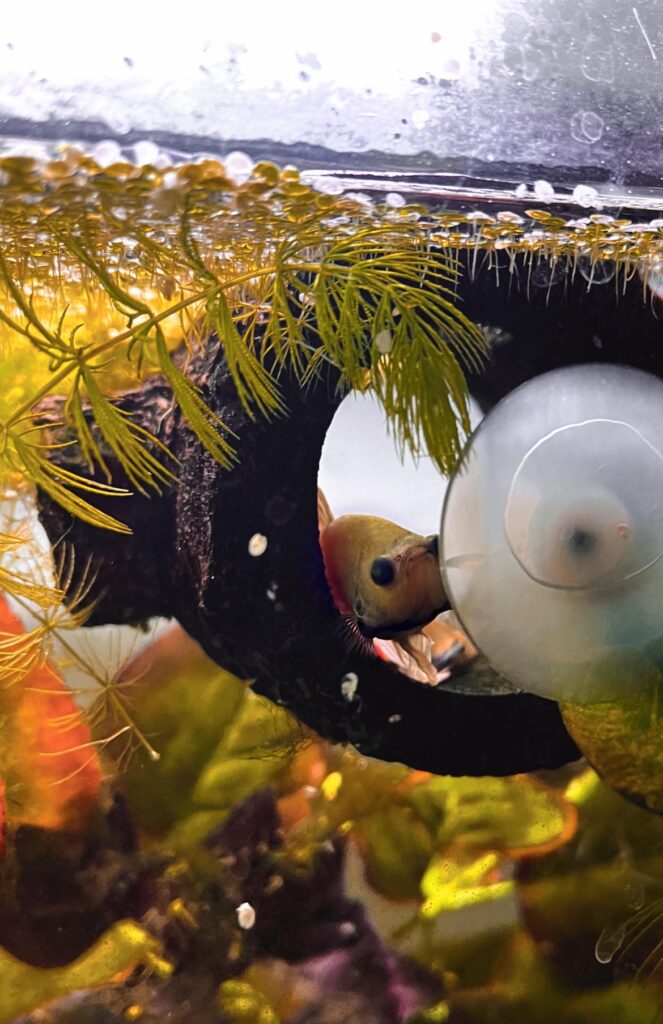
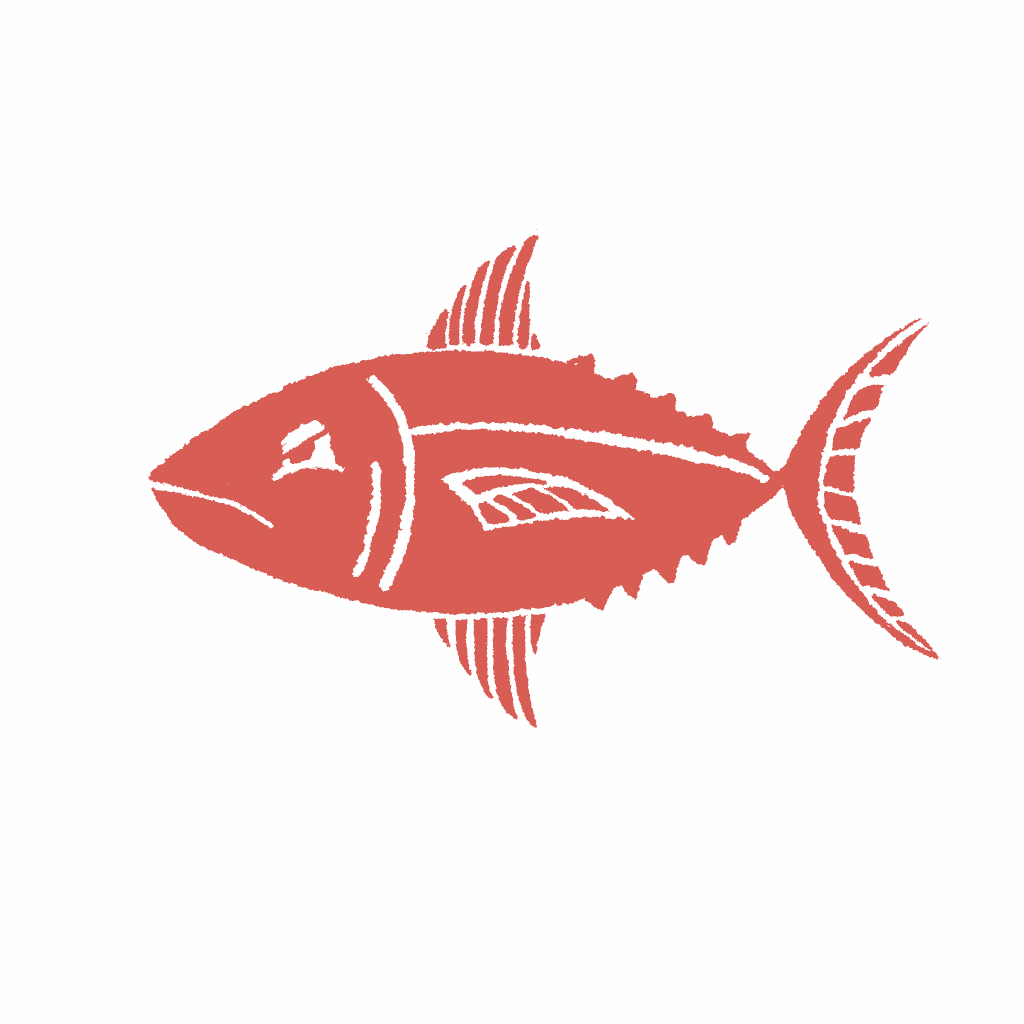
What Does ‘Unacceptable’ Mean?
At The Open Sanctuary Project, unacceptable means that we cannot condone (or condone through omission) a certain practice, standard, or policy. See a more detailed explanation here.
Research Your Species Carefully To Determine The Best Living Conditions For Them
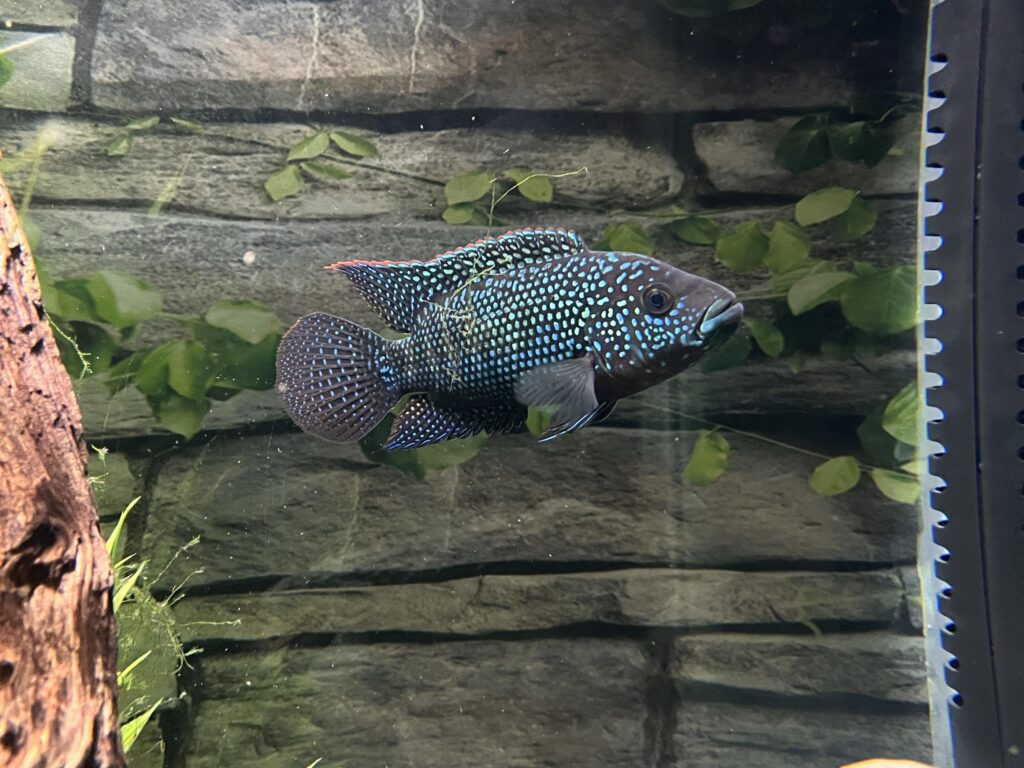
Getting granular, you will find that living spaces are pretty species-dependent. It’s going to come down to a lot of your own research, and it’s critical that you spend some time doing that prior to committing to care long-term for any given species. While we can’t list all the requirements for every species that you may encounter that needs rescue, we can provide you with a general list of considerations to guide you in researching what you’ll need to know. Keep in mind that animal-centered design is not just for terrestrial species! As mentioned briefly above, creating living spaces that keep in mind animals’ core needs as well as other features that promote health and safety are very helpful to providing a great environment for your fish residents to thrive!
Research Tip
Many websites and sources may list minimum requirements. Don’t settle for minimum requirements, but go beyond to learn as much as you possibly can about what conditions a particular species needs not just to survive but to thrive! Keep carefully in mind what the interests are of the person who is sharing the information and remember that most folks in the “aquarium fish industry” consider fishes to be expendable objects. It isn’t in their best interest as sellers to ensure that any given fish has a long life – after all, they can just profit by selling another fish to “replace” an individual who has passed away prematurely!
- Tank Size. Again, do not stop researching when you find the minimum size requirement for a particular species; keep looking until you find the size tank in which this species will thrive!
- Water Temperature. While generally, many fishes can survive in temperatures ranging from 75-80 (24-26.5℃) again; it is really important to pinpoint the ideal temperature at which your fish residents thrive. Most tanks will require a heater, although there are “cold water” species (like goldfish and minnows) that don’t fall under this generalization
- Social Behavior.
- Are they schooling fishes? Are they solitary? When talking about solitary fishes, we are generally referring to their compatibility with same-species tank mates. There are some fishes that prefer to live alone entirely. It also will depend on the temperament and personality of the individual fish. A common example are bettas. Bettas, no matter their sex, should NEVER occupy the same tank as another betta. Some bettas, however, don’t mind sharing their space with certain other species, such as corydora catfish, smaller plecos, and snails. Again, it comes down to the individual. Some bettas are particularly territorial and attack any fish or snail they perceive to be intruding. Some bettas are more easygoing and can cohabitate with these other slow-swimming, not brightly colored, non-threatening species. Always be prepared to rehouse any potential tank mates should you observe any discomfort between tank mates. Other questions to ask include: are the fishes you are caring for known for being aggressive toward other fishes? Do they prefer many hiding places, or do they need open room to swim?
- Preferred Water Parameters.
- This mainly refers to the general hardness (GH) of your water. The two most common elements that contribute to GH are calcium and magnesium. GH is generally measured in degrees (or dGH) rather than mg/L or ppm. One dGH is equal to 17.9 mg/L or 17.9 ppm. Most fishes can adapt to a wide range of GHs, but keep it within reason (e.g., make sure you aren’t taking in a species that thrives in soft water if your water is excessively hard). 0 ammonia, 0 nitrite, low nitrate, and stable pH are always a must, no matter the species. Also, remember GH and KH discussed above! Most fishes can easily adapt to any reasonable pH (5.5-8.6 can be considered reasonable for lots of species, but use caution) as long as the pH is consistent. This is where you’ll also need to remember your KH! This video can help you navigate the differences between pH, KH and GH, and you can also print out our reference chart above for a quick reminder to keep on hand!
- Breeding Behavior And How To Safely Prevent Breeding. Remember that because there is an overwhelming need for sanctuary and because breeding is an exploitative activity, allowing sanctuary residents to breed is unacceptable. This can present special challenges with fish residents, which will require special research to address. Preventing breeding, like most fish-related info, comes down to the species in question. Many egg-laying species will eat their own eggs, or their eggs get eaten by tank mates. Some species, like guppies, will need to be separated by sex to prevent breeding but use caution. You don’t want to separate an African Cichlid, for example, by sex. These males need plenty of females around if they are to cohabitate with other males. In this scenario, female cichlids collect fertilized eggs in their mouths and brood them for three weeks, during which time they will not eat. Breeding is not only unethical, but in this situation, is dangerous to the female. Not eating for three weeks leaves the mother fish weak and vulnerable to disease or bullying. It’s not uncommon for these females to die trying to hatch eggs. In these scenarios, you can safely strip the eggs from the female’s mouth. There are plenty of videos showcasing this practice, as many fish keepers intending to breed take part in this practice to keep the female safe while brooding the eggs in an egg tumbler. Instead, you can simply freeze and dispose of them.
- Tank Mate Compatibility. This is critical if they’ll be living with other fishes. Some species are incompatible with others, and others can do well together. While it is important to keep in mind that every sanctuary resident is an individual, keeping a general awareness of species compatibility can help reduce any potential of conflict between tank mates.
- Tank Level Preferences.
- Are they mid-level dwellers? Top-level dwellers? Bottom feeders?
- This should determine what parts of the tank you leave open for their swimming behavior (e.g., many mid-level dwellers don’t appreciate a bunch of plants or tall decor obstructing where they want to swim.)
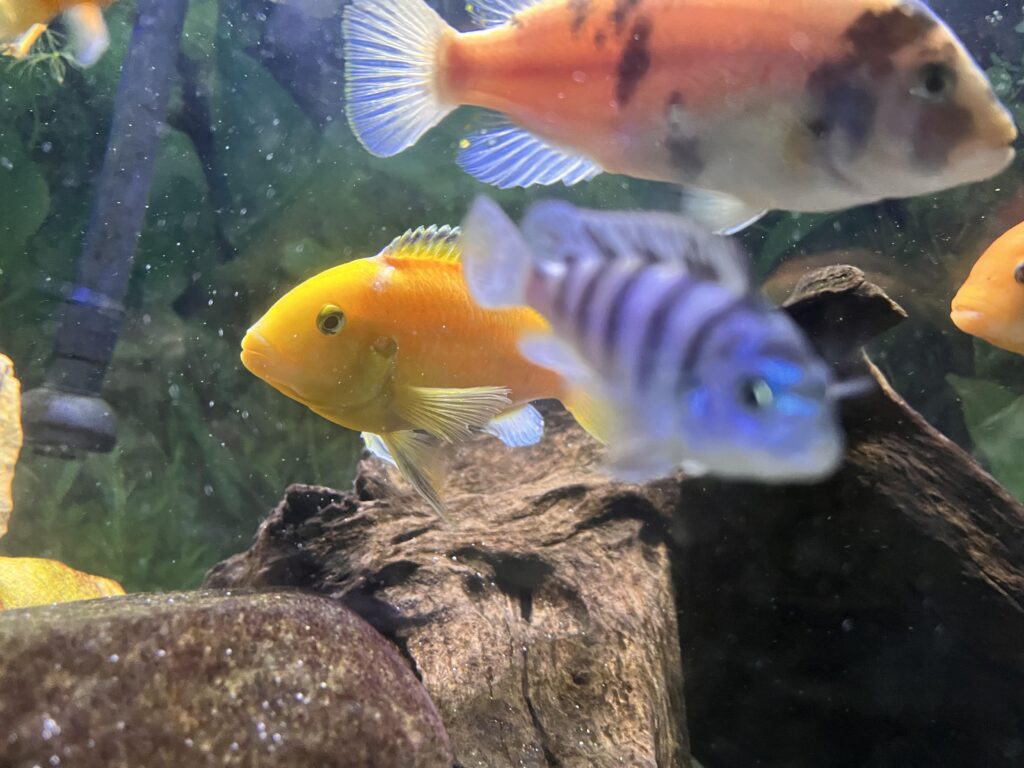
Again, there’s plenty of misinformation out there about all of these topics, sadly. Many of the same websites providing this information are also trying to sell you fishes. To encourage viewers to buy fishes from them, they’ll often downplay the importance of tank size, or give you a wider range of water parameters appropriate for a species, etc. When researching a species, these are some general guidelines for you to follow:
- Read many different sources. Take note of overlapping information and dig further into the inconsistencies.
- Keep in mind which sources are also trying to sell you the species they’re describing.
- Find a fish-savvy person you trust who you can bounce information off of. Even if they don’t have the species you’re considering taking in, two minds are better than one. Do be cautious about non-compassionate community forums, however. Consider joining the “Vegans with Fishes” Facebook group to make these connections!
- The more specific the information you are being offered, generally the more truthful. But make sure to remember Rule 2!
- Keep in mind species compatibility and apply Rule 1 when finding out who can live with whom.
Check Out The Open Sanctuary Project’s Information Sourcing Criteria As Well When Evaluating Information!
At The Open Sanctuary Project, we know that our sourcing is not often perfect because we are working in a very imperfect system. However, we observe certain guidelines and standards when we source information and list it in our resources, and we have shared those standards publicly. We hope that these criteria can also be helpful to our audience in assessing information on subject matter like that listed above!
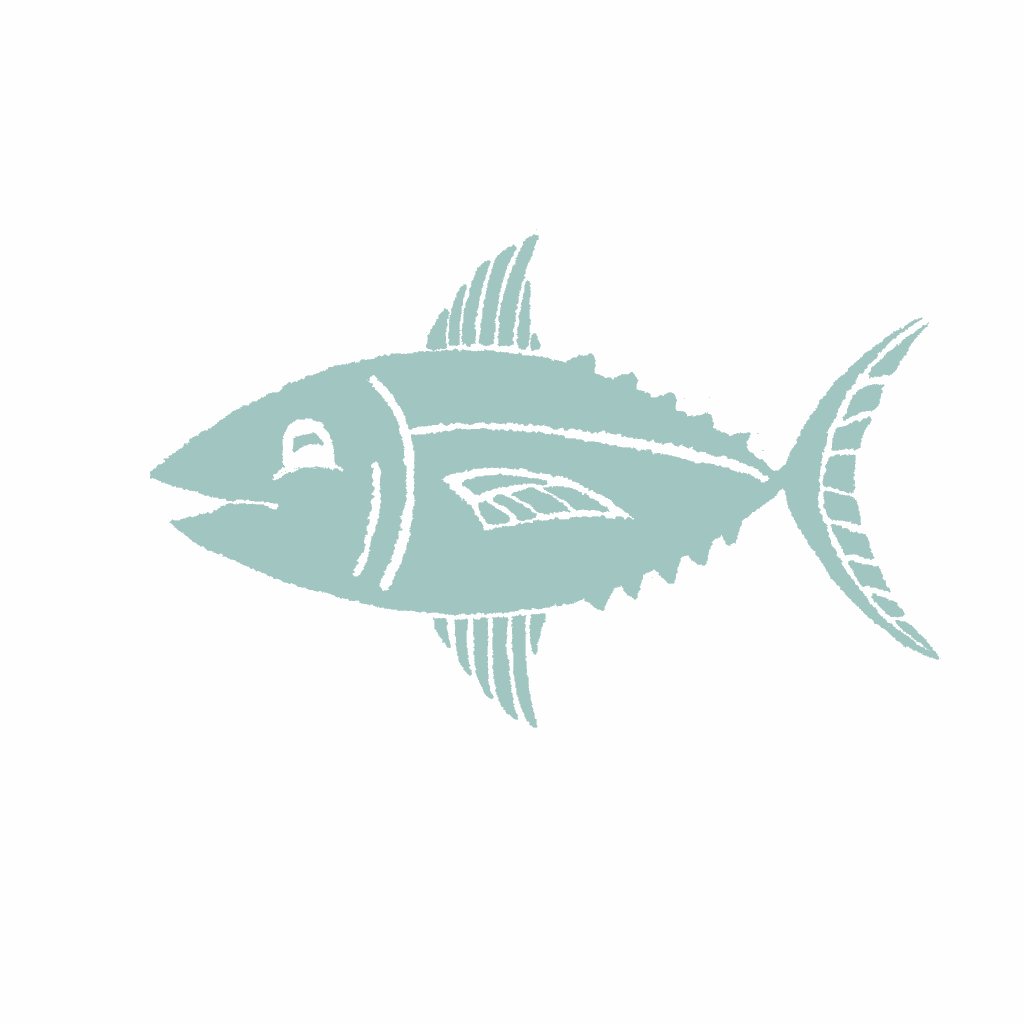
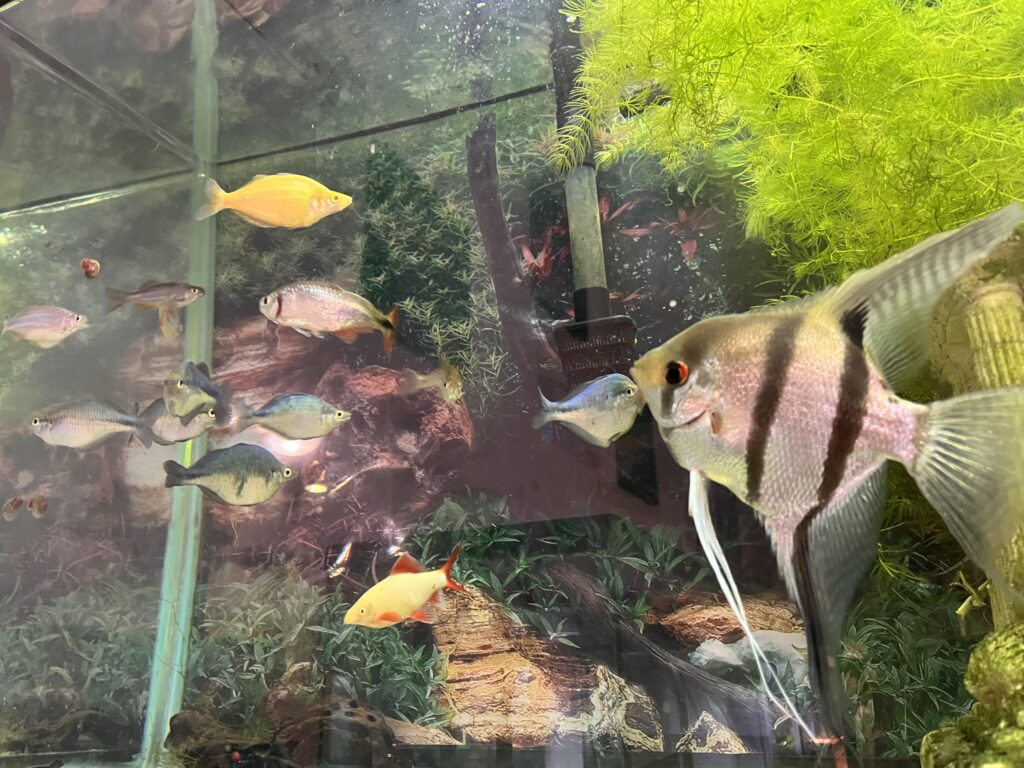
Plants
Live plants are great for your tank’s ecosystem and are natural enrichment for fishes. However, just like with terrestrial species, fishes require careful biosecurity considerations. Aquatic plants can easily introduce bacteria and parasites to your fishes’ environments! So no matter where you get your live plants from, they must be quarantined! We recommend that you quarantineThe policy or space in which an individual is separately housed away from others as a preventative measure to protect other residents from potentially contagious health conditions, such as in the case of new residents or residents who may have been exposed to certain diseases. all aquatic plants separately from fishes for 30 days prior to introducing them to their environment. To learn more about plant quarantine procedures, you can visit this link!
As mentioned above, while many folks consider plants to be largely beneficial to tanks in terms of facilitating the nitrogen cycle, the truth is a bit more complicated. Plants, just like food and fish waste, can be a source of ammonia if they start dying. Make sure to research lighting requirements, pH thresholds, nutrient requirements, trimming practices, etc., to know for sure that the type of plant you’re getting will have a good shot at surviving in your tank. There are Facebook groups dedicated specifically to live aquarium plants and aquascaping that can be useful.
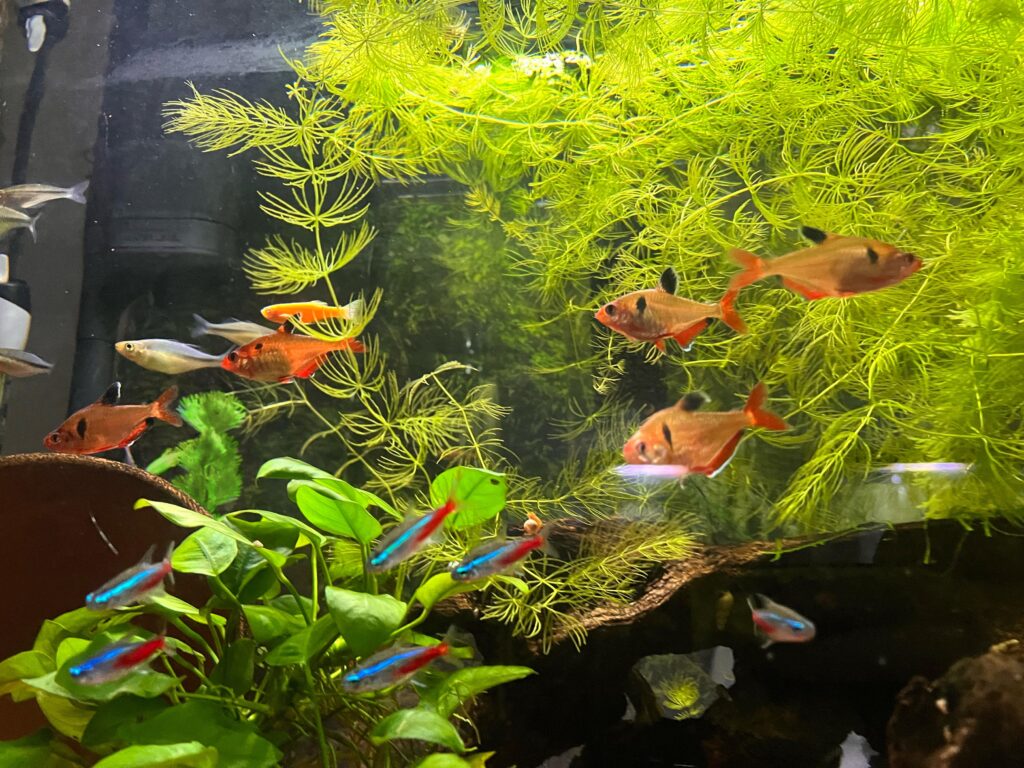
Sanitizing Decor Or Used Tanks
Chances are that you will want to introduce some decor to your fishes’ living spaces, whether it be for enrichment or to provide sheltering spaces for shy individuals. Chances also are that you may find yourself utilizing previously used tanks or decor as you create homes for your fish residents. Again, there are some important biosecurityMerck Veterinary Manual defines biosecurity as ”the implementation of measures that reduce the risk of the introduction and spread of disease agents [pathogens].” concerns with this! There are some careful practices you should employ in order to ensure that your fishes stay safe!
- -Using boiling water is tried, true, and safe! A quick dip in boiling water for items that can withstand it will do the trick!
- Never use soap or random chemicals to clean your tank or decor.
- Do not use any chemicals on porous materials (terracotta pots, etc), always boil them.
- Diluted bleach can be a great way to sanitize decor or used tanks, and this is how you use it.
– Soaking decor or used tanks in 1 part 100% bleach to 20 parts water for a few minutes works very well. After soaking, make sure to rinse whatever was exposed to bleach thoroughly with hot water for several minutes.
-Diluted white vinegar also works well!
-Follow the same procedure as with the bleach, but with equal parts vinegar and water.
Nutrition
Philosophy Of Care Considerations
If your sanctuary is contemplating caring for fishes, one consideration you may wish to take into account is that many fishes do eat other animals, and thus require animal protein for their ongoing health and well-being. If providing this kind of diet to your fish residents creates an ethical conundrum for your sanctuary caregivers and administrators, you may wish to consider whether caring for fishes falls within your philosophy of care, and is in accordance with your mission and vision.
Unsurprisingly, fish nutrition is a relatively unexplored topic. There are, however, steps we can take to do our best when it comes to providing as appropriate a diet as possible. You’ll want to take into account a few things when choosing your fishes’ diets. Variety is good for fishes, but a high-quality staple food is just as important. Here are some good general rules to follow:
- Research and consider what your species of fish eats in the wild.
- Avoid giving “feeder” fish to carnivorous fishes.
- “Feeders” are unethical because they’re almost always unnecessary.
- “Feeders” often carry disease and their introduction can compromise the biosecurity of your tanks.
- “Feeders” aren’t very nutritional anyway (e.g. one Hikari Carnistick has the same caloric value as a “feeder” goldfish)
- Consider the quality of various brands of fish food. Consult with skilled and compassionate caregivers! Hikari, Omega One, and Repashy are a few brands considered to be of higher quality by compassionate caregivers of fishes.
- Don’t get bogged down on the ingredients themselves. Focus more on the nutritional breakdown. For example, consider the percentage of protein, fat, fiber, and vitamins in the food when evaluating it for your fish companions.
- Join Facebook or other community groups that are focused specifically on the fish species you are caring for. While these groups may not be focused on the ethical and compassionate care of fishes, they can be helpful when it comes to seeing what others feed their fishes.
- Utilize fish multivitamin supplements. Vitachem is a product many rescuers have used with success. It is a once-a-week multivitamin added directly to the water after water changes to help prevent nutrient deficiencies, and it can also be mixed with food.
- The quantity of food will depend on a few factors. First being species, second being age, and third being how fast the individual eats. Most fish foods will have feeding guidance on the back of the package, but there’s no way for these companies to know who your fish is and how they eat. This, again, is one of those instances where you’ll need to do your own research. Take what fish food companies suggest with a grain of salt. Visit species-specific groups on Facebook, ask in VegansIndividuals who seek to eliminate the exploitation of and cruelty to nonhuman animals as much as possible, including the abstention from elements of animal exploitation in non-food instances when possible and practicable as well. with Fishes, and pay attention to YOUR FISH! Above all advice you can get, you can usually go based on your fish’s body language. After eating, are they still frantically searching for more food? That might mean they need more. Pay attention to your fish’s weight (size). Each species is different, but you can often best gauge your fish’s body fat by looking at them from an overhead view. This process will take some trial and error. When in doubt, smaller, more frequent meals are better than fewer, larger meals.
Avoid Nutrient Loss!
The nutrition in food can degrade over time. This is true of food for any species, including humans! When it comes to food for fishes, there are five main factors to be aware of. Heat, light, water, oxygen and time of storage can all impact the nutritional value of your fishes’ food. This resource can offer some guidance on ways to make sure you store food in a way that minimizes nutrition loss. We also recommend generally that unused dry fish food be replaced every 6 months to avoid nutrient loss.

The Acclimation And Transport Of Fishes
So you’ve planned for living spaces, done your research, set up and cycled a safe living space. And now you’ve arranged for the rescue of some fishes! Congratulations! However, you are not out of the woods yet in terms of what you need to know to get these fishes safely to sanctuary.
Fishes can go into shock easily. There are some critical steps you must take to minimize stress and shock when bringing your fishes home, and these will also apply when it comes to moving them for any reason!

The Importance of Quarantine!
We strongly recommend that new fishes must be quarantined for a period of no less than 30 days prior to being introduced to any existing fish residents that you may have. This link offers some helpful guidance.
Acclimation
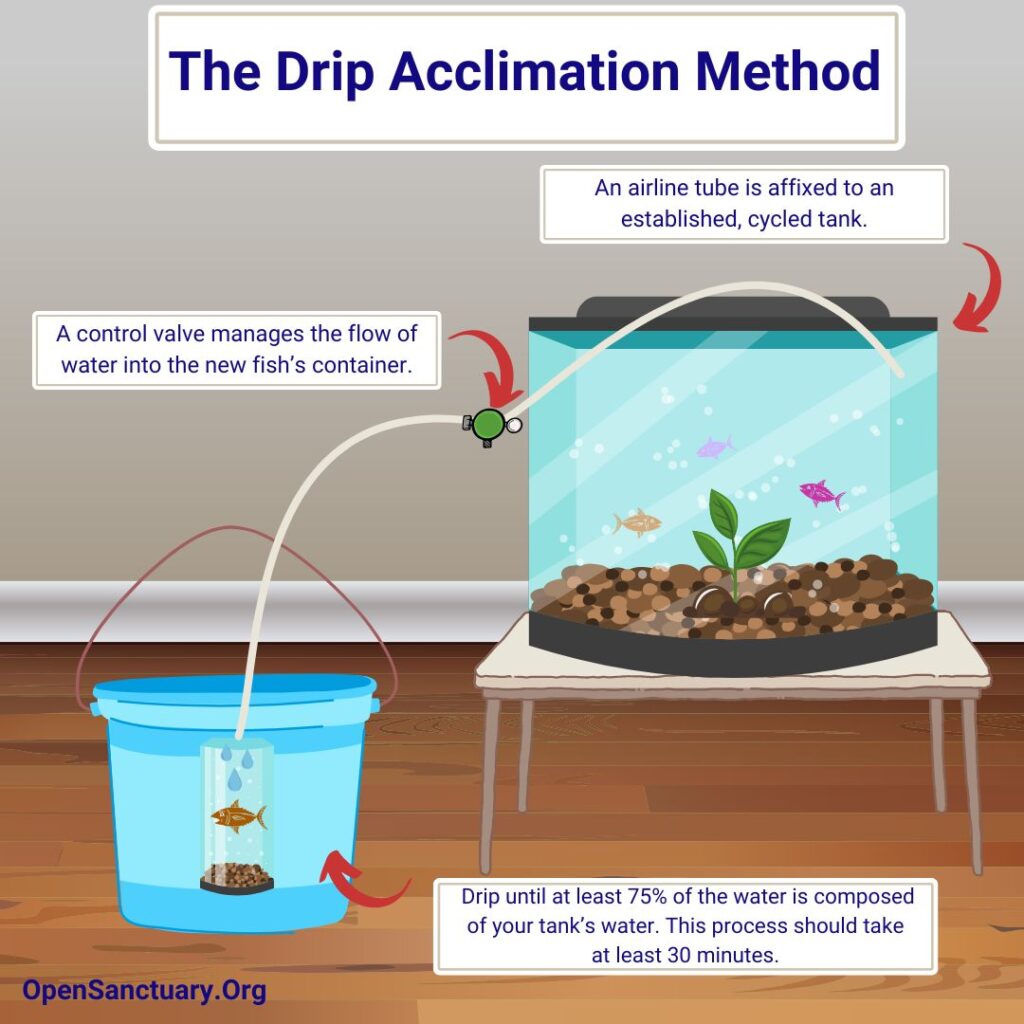
Acclimation is a relatively simple yet monumentally important topic when it comes to fish care. Sudden change is a fish killer. The tried and true method used by many compassionate rescuers of acclimating a fish to a new environment is the ‘drip acclimation method’. Simply take some clean airline tubing, cut it in half and connect the two halves with an air control valve. Next, create a vacuum via gravity (by sucking on the lower end of the tube) to force your tank’s water to flow downward to the water the fish is in, and use the control valve to manage the flow. The drip rate depends on the size of the container the fish is in. The smaller the container, the slower the drip should be. 2-3 drips per second is average. Continue dripping until at least 75% of the water is comprised of your tank’s water. This process should take at least 30 minutes. If you’re going to reach 75% before 30 minutes, reduce the drip rate. The video below demonstrates a proper drip tube.
Video Resource: The Drip Acclimation Method With Cameron Edwards
After being properly drip acclimated, you still must temperature acclimate. With regards to thermometers, we suggest the following:
– Use at least two mercury-based thermometers made specifically for aquariums to ensure accuracy. Also, ensure the thermometer used to adjust water temp for refilling post-water change displays the same temps as the ones in the tank.
– Avoid digital thermometers. They are notoriously inaccurate and can become more so as batteries deplete.
Float the fish’s container in the tank. The temperature of the two bodies of water will slowly reach an equilibrium. Note that this process must also be slow. Don’t allow the temperature to change more than a couple of degrees over the course of 20 minutes. Once the waters are roughly the same, you may gently release the fish into their new home or quarantine tank.
Care With Lighting Can Help Mitigate Stress!
Keep lights low to mitigate stress. New environments and new humans can be overstimulating to a fish. Low lighting will help keep them calm during this big move!

Transport
Animal transport can present significant challenges to compassionate caregivers, and this can be particularly true in the case of fishes. Sometimes, in rescue contexts, transport conditions will be out of your hands. For the sake of simplicity, this section will refer to ideal conditions for the transport of fishes. Matching these conditions as closely as possible will spell a successful transport for your fishes. There are a few items you’ll want to have for your fishes’ big trip. The first thing you will need is a temperature-trapping container (a picnic cooler is a good option) big enough to hold the container your fish is in (but not too big!). Pad the inside with newspapers or the like to prevent the container from sliding around. With transport, you should generally avoid using 12-volt power inverters with aquarium heaters. There have been some unfortunate cases involving power inverters and electric shocks to fishes. A good old-fashioned cooler is much safer. The second thing you will need is a portable aerator/bubbler. Keep the bubbler outside both containers, running a tube and airstone to the water. This will keep the water properly oxygenated for your fishes as they are in transport!
The Medical Care And Handling Of Fishes
Medical Care
Put simply, the importance of veterinary care for every animal sanctuary resident cannot be understated. Fishes are not an exception to this principle. While finding veterinary care for fishes may be more challenging than for other sanctuary residents, the medical care of fishes should be done by or under the guidance of a qualified and skilled veterinarian. This site can help you to find a fish vet near you. If there are none in your area, this site offers a unique service under “Aquatic Veterinary Consult.” This service allows your exotics veterinarian to consult with an aquatic vet online to get proper directions for treating your fish. Establishing and maintaining a good relationship with a veterinarian is a key component when it comes to the responsible rescue and care of fishes. Consulting that fish-savvy friend you’ve made or the Vegans with Fishes group can also be a good idea to help gauge if your fish needs to see a vet. If you have more than one fish, you should keep a “hospital” tank on standby so the sick fish can be separated from the rest, if applicable. Note: If the water in the hospital tank comes from the same source as your main tank’s water, there’s no need to drip acclimate. You only have to temperature acclimate in these scenarios. It’s also a good idea to keep an extra tank on hand if you have snails. Snails cannot handle high levels of salt (read below) and will need to be removed from the tank if salt treatments are needed.
Of course, we want to stress the importance of daily observation of your fish residents. Observation is a critical tool for caregivers to get to know what is normal and what is not for their fish residents and can help caregivers catch and address any potential issues as early as possible. Careful research on the species for whom you care is also critical so you are aware of any warning signs and can keep your eyes out for them!
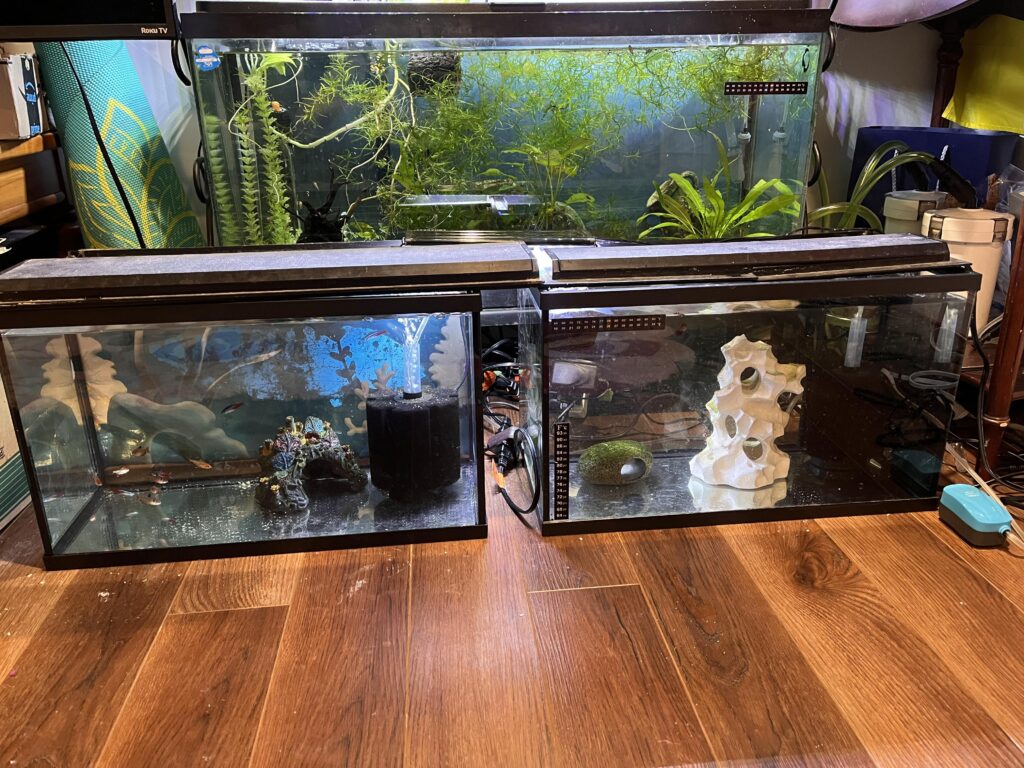
Again, we want to stress that you should always consult with a veterinarian before commencing any treatment for your fishes!
It’s Not Just About Prescription Meds
While many medications require a veterinary prescription, some do not (as of this writing, there are even some commonly-used antibiotics that are available without a prescription, though this is in the process of changing). Just because you can head over to your aquarium store or hit up an online supplier and get certain supplements or medications, this does not mean they should be used haphazardly. It’s still important to work with your veterinarian to ensure that 1) the treatment in question is appropriate given the circumstances and 2) that you are administering the treatment correctly. Using medications without veterinary advice could result in harm to your residents and, in the case of antimicrobials, can also lead to promoting antimicrobial resistance. We strongly recommend working closely with your veterinarian when making decisions regarding the administration of any supplement or medication.
It’s a good idea to keep aquarium salt and a kitchen scale on hand for measuring/dosing, as this is a frequent recommendation for treatment to begin. You can find an aquarium salt dosing calculator here. A sick and/or aging fish may benefit from aquarium salt as it reduces the amount of work their kidney and gills have to do. A fish’s kidney, gills, and skin are constantly battling against osmosis with the water they’re swimming in. Salt reduces that workload and increases a fish’s slime coat production. One part per thousand (1ppt) is the typical dose for an older fish who may start experiencing reduced kidney function. Three parts per thousand is the typical dose for a sick fish. Temporary aquarium salt usage for scaled fishes is appropriate to start on your own, but if a fish’s condition does not improve after a couple days they should be seen by a qualified vet.

A Note On Salt Safety!
The doses mentioned above are not safe for live plants or snails. Further, SALT IS NOT SAFE FOR SCALELESS FISH AND INVERTEBRATES. Make sure your fish is not considered scaleless prior to using salt, and as always, consult with your veterinarian prior to using any treatment on your fishes.
Handling
Handling of fishes should be kept to an absolute minimum. When moving fishes, it’s best to scoop them with a container rather than using a net. It’s extra stressful and disorienting for fishes to be taken out of their water. Sometimes nets are unavoidable for particularly evasive fishes. Keep out of the water time to an absolute minimum. Touching a fish with your hand isn’t safe. Fishes have slime coats, a thin protective layer of mucus covering their bodies. Fishes need their slime coat for many reasons, including locomotion and parasite/disease prevention. Touching a fish can rub this layer off and cause them harm. If handling is necessary for medicating, hand feedingThe act of feeding an animal by hand, such as giving a carrot directly from the palm of one’s hand to a horse’s mouth., egg removal, or any other reason, always use powder-free nitrile-based gloves.
Conclusion
Work on how to compassionately care for fishes is a relatively new realm in the sanctuary world. Given the vast diversity of fishes in need of rescue and their associated diverse needs, it is impossible to provide a fully comprehensive guide to the needs of all the fishes you may encounter, but we very much hope that the basics provided in this introductory resource can be of assistance to caregivers and to fishes. Look forward to more resources on the care of fishes to come!
Action Steps
- If you are interested in rescuing fishes, or providing them with sanctuary, the first thing you need to do is significant research into water chemistry generally and into the species that you will be caring for.
- When you do your research, make sure to think critically and carefully about the sources from which you are gathering information.
- Ideally, prior to rescuing fishes, work on cycling tanks appropriate for the species you intend to care for without fish in them so that you can learn through experience the nuances of the nitrogen cycle and how to maintain a stable tank safe for fish residents. This will ensure your new fishes have a home or a quarantine tank they can move into right away.
- Ideally, prior to rescuing fishes, identify and establish a relationship with a qualified veterinarian willing to treat fishes, and establish links with knowledgable, ethical and compassionate caregivers who can give you advice and guidance.
- Always take steps to make sure that fishes who must be transported, handled, or acclimated are cared for in a way that is respectful of their needs as aquatic beings and that minimizes stress and trauma to them.
SOURCES:
Determining Your Animal Sanctuary’s Capacity For Responsible Care | The Open Sanctuary Project
A Sanctuary’s Guide To Fish Advocacy And Care: Part 1 | The Open Sanctuary Project
The Plight Of Farmed Fishes | The Open Sanctuary Project
Breaking The Mold: How Animal-Centered Design Can Transform Sanctuaries | The Open Sanctuary Project
Information Sourcing Considerations At The Open Sanctuary Project | The Open Sanctuary Project
What Does “Philosophy Of Care” Mean At The Open Sanctuary Project | The Open Sanctuary Project
Biosecurity Part 1: Introduction | The Open Sanctuary Project
Observation: An Important Caregiving Tool | The Open Sanctuary Project
The Importance Of Veterinary Care At Your Animal Sanctuary | The Open Sanctuary Project
Vegans With Fishes Community On Facebook
Find A Fish Vet | The American Association Of Fish Veterinarians
Fish Veterinary Services | Aquatic Veterinary Services
The Easy Guide To The Nitrogen Cycle For Aquariums | Aquarium Co-op (Non-Compassionate Source)
How To Properly Gravel Vacuum A Fish Tank (Detailed Version) | Aquarium Co-op (Non-Compassionate Source)
Clean Your Disgusting Aquarium Filter, When, How And Why | KGTropicals (Non-Compassionate Source)
How To Cycle Your New Aquarium? The Easy Way (Beginner Friendly) | Fish Lab (Non-Compassionate Source)
pH: Chemistry | Britannica
How To Fishless Cycle A Tank With Ammonia (Complete Guide) | Build Your Aquarium (Non-Compassionate Source)
Emergency: Performing a Fish-in Cycle The RIGHT Way | Fish Lab (Non-Compassionate Source)
Beginning Guide To Aquarium KH – Part 1: What Is KH And Why Is It Important? | DMichaels Fish Den (Non-Compassionate Source)
Why Your Ammonia Test Kit is Probably Lying to You! | Prime Time Aquatics (Non-Compassionate Source)
Efficacy Of Quick-Start Nitrifying Products In Controlled Fresh-Water Aquaria | Science Direct (Non-Compassionate Source)
Aquatic Care: Fish Tank Temperature Control | Thermometer World (Non-Compassionate Source)
How To Quarantine Aquatic Plants | Aquatic Veterinary Sciences (Non-Compassionate Source)
Dietary Protein And Energy Requirements Of Juvenile Freshwater Angelfish | Scientific Electronic Library Online Brazil (Non-Compassionate Source)
Five Things That Ruin Fish Nutrition | Advanced Aquarium Concepts (Non-Compassionate Source)
Quarantine Your Fish Yourself | Aquatic Veterinary Services (Non-Compassionate Source)
Adding New Fish? How To Drip Acclimate New Fish To Your Tank | DMichaels Fish Den (Non-Compassionate Source)
Non-Compassionate Source?
If a source includes the (Non-Compassionate Source) tag, it means that we do not endorse that particular source’s views about animals, even if some of their insights are valuable from a care perspective. See a more detailed explanation here.








